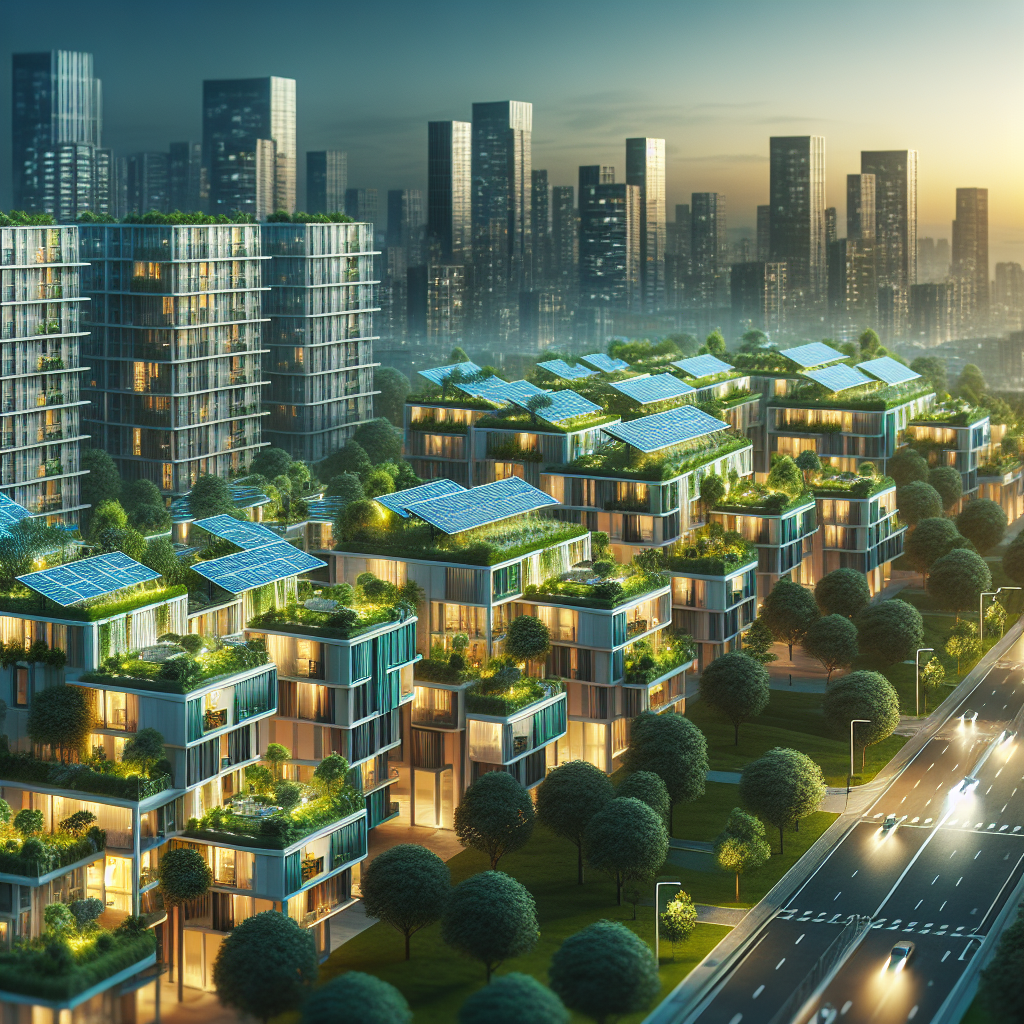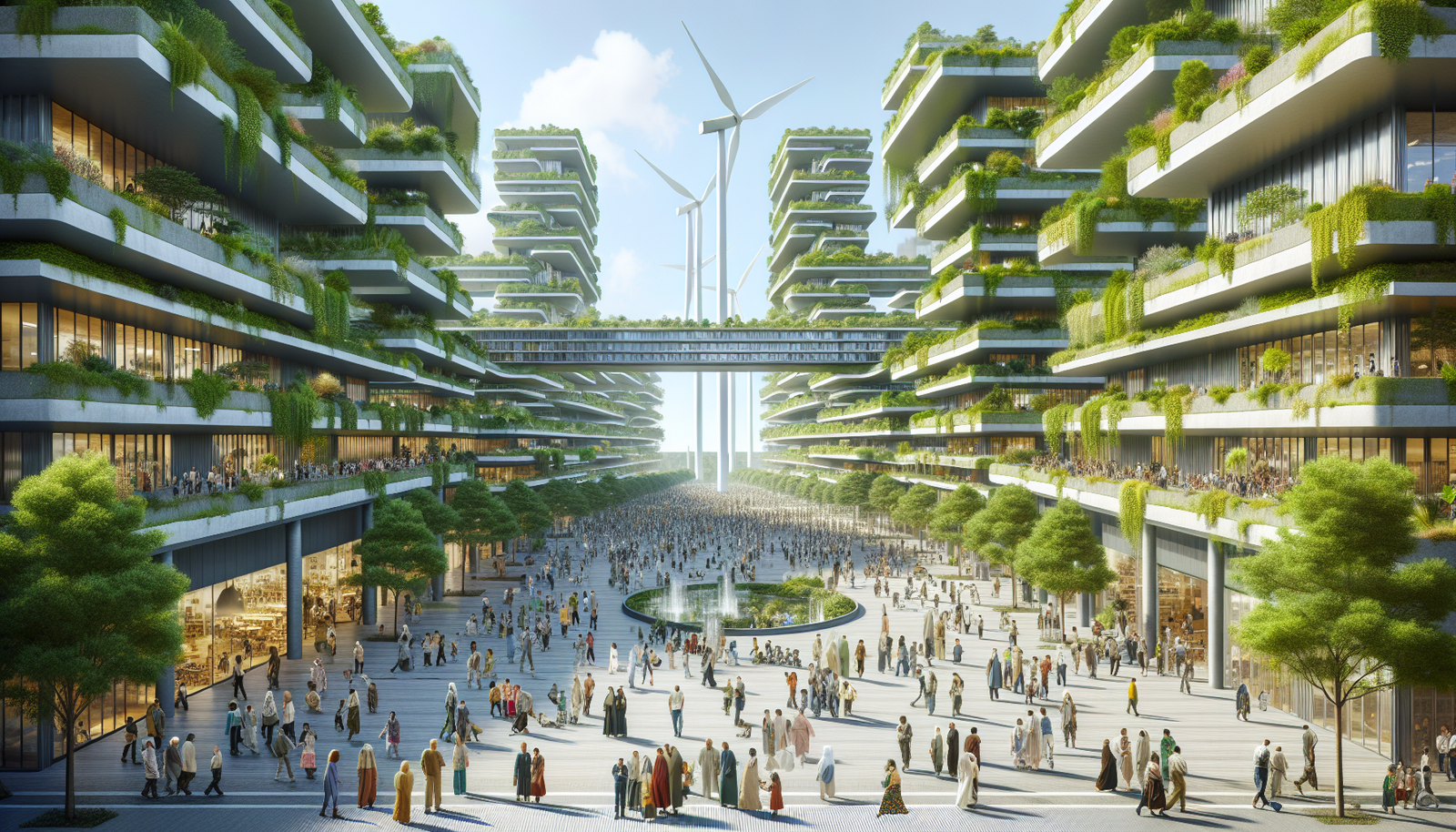Understanding Sustainability in Development
Sustainability in development is a multifaceted concept that integrates economic growth, social equity, and environmental protection. As global challenges such as climate change and resource depletion intensify, the need for sustainable development becomes ever more critical. The concept of sustainability ensures that current development meets the needs of the present without compromising the ability of future generations to meet their own needs. This balance is crucial for maintaining the health of our planet and the well-being of its inhabitants.
One of the key aspects of understanding sustainability in development is recognizing the interconnectedness of various sectors. Economic growth must go hand-in-hand with social inclusion and environmental stewardship. To illustrate this, consider the following table that outlines the three pillars of sustainability:
| Economic | Social | Environmental |
|---|---|---|
| Resource Efficiency | Equity and Justice | Conservation of Biodiversity |
| Innovation and Technology | Community Development | Pollution Reduction |
| Job Creation | Access to Education | Climate Change Mitigation |
Technological innovations play a vital role in achieving sustainable development. Advances in renewable energy, waste management, and sustainable agriculture are transforming how societies develop. These technologies not only reduce the environmental footprint but also create economic opportunities and enhance social well-being. For instance, the adoption of solar and wind energy has led to the creation of thousands of jobs worldwide, illustrating the economic benefits of sustainability.
Moreover, policy frameworks are essential in promoting sustainability. Governments and international organizations have developed a range of policies to encourage sustainable practices. These include regulatory measures, incentives for green technologies, and educational programs to raise awareness about sustainability. A comprehensive policy approach ensures that sustainability is embedded in all aspects of development, from urban planning to industrial practices.
The Economic Benefits of Sustainable Practices
Incorporating sustainable practices into development strategies offers numerous economic benefits that can enhance profitability and ensure long-term growth. A key advantage is the reduction in operational costs. By implementing energy-efficient technologies and optimizing resource use, businesses can significantly lower their energy and material expenses. For instance, companies investing in renewable energy sources like solar and wind power can reduce their reliance on fossil fuels, leading to substantial savings over time.
Moreover, sustainable practices can open up new market opportunities and drive innovation. As consumer demand shifts towards eco-friendly products and services, businesses that prioritize sustainability are better positioned to capture this growing market segment. Companies adopting sustainable models often find themselves at the forefront of technological innovations, which not only boosts their competitive edge but also fosters economic resilience. The emphasis on sustainability encourages the development of new products and services, creating jobs and spurring economic activity.
The economic benefits of sustainable practices are also evident in risk management and resilience. By reducing dependency on non-renewable resources and minimizing waste, companies can protect themselves from volatile market fluctuations and supply chain disruptions. Sustainable practices contribute to a more stable and predictable business environment, which is crucial for long-term planning and investment. Additionally, businesses that embrace sustainability are likely to benefit from favorable policy frameworks and incentives offered by governments aiming to promote sustainable development.
The following table highlights some of the key economic benefits associated with sustainable practices:
| Benefit | Description | Example |
|---|---|---|
| Cost Reduction | Lower operational costs through energy efficiency and resource optimization. | Reduced energy bills from solar panel installation. |
| Market Opportunities | Access to new markets by meeting consumer demand for sustainable products. | Increased sales of eco-friendly goods. |
| Risk Management | Improved resilience against market and environmental risks. | Stable supply chains through reduced resource dependency. |
| Innovation | Encouragement of technological advancements and new business models. | Development of green technologies and solutions. |
Social Impacts of Sustainable Development
Sustainable development significantly influences social structures by fostering inclusive growth and equitable resource distribution. One of the key social benefits is the reduction of poverty through the creation of green jobs and the promotion of sustainable livelihoods. By emphasizing renewable energy, sustainable agriculture, and eco-friendly industries, communities can achieve economic stability while preserving their natural resources.
Moreover, sustainable development initiatives often lead to improved health outcomes. For instance, reducing pollution and enhancing access to clean water and sanitation facilities can dramatically decrease the incidence of diseases. The shift towards sustainable urban planning and transportation systems also contributes to healthier lifestyles by encouraging walking, cycling, and the use of public transport.
Education plays a critical role in the social dimension of sustainable development. By integrating sustainability into education systems, communities can nurture a generation that values environmental stewardship and social responsibility. This educational transformation empowers individuals to participate actively in sustainable practices, fostering a culture of innovation and resilience.
The table below highlights some key social indicators improved by sustainable development:
| Indicator | Impact |
|---|---|
| Employment | Increased job opportunities in renewable sectors |
| Health | Reduction in pollution-related diseases |
| Education | Integration of sustainability in curricula |
In summary, sustainable development not only addresses environmental and economic challenges but also yields substantial social benefits. By prioritizing sustainability, societies can achieve long-term prosperity and well-being for all citizens.
Environmental Health and Sustainability
Environmental health plays a pivotal role in sustainability, ensuring that ecosystems continue to thrive while supporting human needs. The degradation of natural resources and ecosystems leads to adverse effects on both biodiversity and human health. Preserving environmental health is essential for sustainable development as it directly influences air quality, water resources, and soil fertility.
One of the most significant aspects of environmental health is air quality. Poor air quality can lead to respiratory diseases and other health complications, which can impede development efforts. Efforts to improve air quality include reducing emissions from industrial activities and increasing green spaces in urban areas. These changes not only improve public health but also enhance the quality of life and sustain economic growth.
Additionally, the management of water resources is crucial for sustainability. Access to clean water is a fundamental human right and a cornerstone of sustainable development. Effective strategies for water management include the implementation of advanced filtration technologies and sustainable agricultural practices that minimize water wastage. These measures help maintain the balance of aquatic ecosystems and ensure the availability of water for future generations.
The following table highlights key environmental health indicators and their impact on sustainability:
| Indicator | Impact on Sustainability |
|---|---|
| Air Quality | Improved air quality enhances health outcomes and reduces healthcare costs, supporting economic stability. |
| Water Quality | Access to clean water is vital for public health and agriculture, contributing to sustainable development. |
| Soil Health | Healthy soils support biodiversity and food security, which are essential for sustainable growth. |
Moreover, the integration of technological innovations is transforming the way we address environmental health challenges. Technologies such as remote sensing and geographic information systems (GIS) provide valuable data for monitoring environmental changes and implementing effective sustainability strategies. By leveraging these technologies, policymakers and stakeholders can make informed decisions that promote environmental health and sustainability.
Technological Innovations for Sustainable Growth
Technological innovations play a pivotal role in achieving sustainable growth by driving efficiency, reducing resource consumption, and minimizing environmental impacts. These advancements are not only transforming industries but also paving the way for new economic opportunities. The integration of technology in various sectors has led to the development of smart solutions that enhance productivity while prioritizing sustainability.
- Renewable Energy Technologies: Innovations in solar, wind, and hydroelectric power have significantly increased the adoption of clean energy sources. These technologies have become more cost-effective and efficient, making them viable alternatives to fossil fuels.
- Energy Storage Systems: Advances in battery technology, such as lithium-ion and solid-state batteries, have improved energy storage capabilities. This progress is crucial for balancing supply and demand, especially in renewable energy systems.
- Smart Grids: The implementation of smart grid technology facilitates efficient energy distribution and consumption. It enables real-time monitoring and management of energy resources, thus reducing waste and optimizing usage.
Moreover, technological innovations extend to the realm of agriculture, where precision farming techniques are revolutionizing food production. By utilizing data analytics, sensors, and GPS technology, farmers can optimize resource use and increase crop yields while minimizing environmental impact.
| Technology | Impact on Sustainability |
|---|---|
| Renewable Energy | Reduces carbon emissions and reliance on non-renewable resources |
| Energy Storage | Enables efficient energy use and enhances grid stability |
| Smart Grids | Optimizes energy distribution and reduces waste |
| Precision Farming | Increases agricultural efficiency and reduces resource consumption |
Finally, policy frameworks and collaboration between governments and private sectors are essential to harness the full potential of these innovations. By investing in research and development and establishing supportive regulatory environments, stakeholders can ensure that technological advancements contribute to a sustainable future.
Sustainability in Urban Planning
Urban planning plays a pivotal role in fostering sustainability within cities, which are home to more than half of the global population. The increasing urbanization trend underscores the need for sustainable practices that address economic, social, and environmental challenges. Sustainable urban planning involves creating urban spaces that are not only efficient but also resilient to future challenges. This entails the integration of green spaces, efficient public transport systems, and sustainable housing solutions. By prioritizing these elements, cities can reduce their carbon footprint and enhance the quality of life for their residents.
One of the key components of sustainability in urban planning is the development of green infrastructure. This includes the implementation of parks, green roofs, and urban gardens which serve multiple purposes. Not only do they provide recreational spaces and improve air quality, but they also help in managing urban heat and stormwater runoff. The introduction of these green elements is crucial in combating the urban heat island effect, which is a common issue in densely populated areas.
| Element | Impact |
|---|---|
| Green Spaces | Improve air quality, reduce heat, provide recreation |
| Public Transport | Reduce traffic congestion and emissions |
| Sustainable Housing | Minimize resource use, lower energy costs |
Another essential aspect is the enhancement of public transportation systems. Efficient and reliable public transport reduces the dependency on personal vehicles, thus decreasing traffic congestion and lowering greenhouse gas emissions. Sustainable urban planning encourages the development of bicycle lanes, pedestrian pathways, and the use of electric buses and trains. These initiatives not only contribute to cleaner air but also support economic growth by improving accessibility and reducing travel times.
Moreover, sustainable urban planning advocates for the construction of energy-efficient buildings. These structures make use of advanced technologies and materials to minimize energy consumption and reduce waste. The incorporation of renewable energy sources such as solar panels and wind turbines in building designs further contributes to sustainability efforts. Overall, integrating these elements into urban planning not only benefits the environment but also promotes healthier and more equitable living conditions for urban populations.
Sustainable Agriculture and Food Security
Sustainable agriculture plays a crucial role in ensuring food security for the growing global population while minimizing environmental impacts. It involves practices that maintain and enhance the quality of the land, water, and other natural resources. By adopting sustainable methods, farmers can increase productivity while preserving ecosystems and biodiversity. Some of these practices include crop rotation, organic farming, and integrated pest management.
The impact of sustainable agriculture on food security can be understood by examining various components:
- Economic Viability: Sustainable farming often leads to reduced input costs and increased resilience to market fluctuations, benefiting both small-scale and large-scale farmers.
- Environmental Health: By reducing reliance on chemical fertilizers and pesticides, sustainable agriculture helps decrease soil degradation and water pollution.
- Social Equity: It supports rural communities by promoting fair labor practices and providing equitable access to resources.
To better understand the correlation between sustainable agriculture and food security, consider the following table, which outlines key indicators:
| Indicator | Conventional Agriculture | Sustainable Agriculture |
|---|---|---|
| Crop Yield | High in the short term | Stable and resilient long term |
| Soil Health | Often degraded | Improved and maintained |
| Water Use Efficiency | Lower | Higher |
| Biodiversity | Decreased | Enhanced |
In conclusion, sustainable agriculture not only contributes to food security but also fosters a healthier planet and a more equitable society. By integrating innovative technologies and supportive policy frameworks, it is possible to transform current agricultural practices into more sustainable systems that meet the needs of present and future generations.
Corporate Responsibility in Sustainable Development
Corporate responsibility plays a pivotal role in the pursuit of sustainable development. As businesses continue to expand globally, their impact on the environment and society becomes increasingly significant. Companies are now expected to integrate sustainable practices into their operations, ensuring that their growth does not come at the expense of the planet or future generations. Corporate responsibility encompasses a wide range of activities, from reducing carbon footprints to engaging in fair labor practices and contributing positively to the communities in which they operate.
One of the major aspects of corporate responsibility is the adoption of environmentally sustainable practices. This includes measures such as reducing emissions, minimizing waste, and utilizing renewable resources. Many corporations have set ambitious targets for reducing their environmental impact. For instance, Company A aims to achieve net-zero emissions by 2040, while Company B has committed to using 100% renewable energy by 2025. These efforts not only help in mitigating climate change but also enhance the company’s reputation and competitiveness in the market.
Social responsibility is another critical component of corporate sustainability. Companies are increasingly focusing on improving labor conditions, promoting diversity and inclusion, and ensuring ethical sourcing of materials. For example, Company C has implemented a comprehensive program to support local communities by investing in education and healthcare. In addition, they have established a strict code of conduct for their supply chain to prevent child labor and ensure fair wages. Such initiatives demonstrate the company’s commitment to social equity and contribute to long-term sustainable development.
Corporate responsibility also involves adherence to policy frameworks and regulations that promote sustainability. Governments and international organizations have established various guidelines to encourage businesses to operate sustainably. For instance, the United Nations’ Sustainable Development Goals (SDGs) provide a blueprint for companies to align their strategies with global sustainability objectives. Many companies have adopted these goals, integrating them into their corporate strategies and reporting progress annually. This alignment not only helps in achieving sustainability targets but also ensures compliance with regulatory requirements and enhances stakeholder trust.
Policy Frameworks Supporting Sustainability
Policy frameworks play a crucial role in advancing sustainability within development projects. These frameworks are designed to integrate economic, social, and environmental considerations into planning and decision-making processes. Governments and international organizations have recognized the importance of establishing robust policies that encourage sustainable practices. By implementing comprehensive policy frameworks, it is possible to create an environment where sustainable development can thrive.
One of the key components of successful policy frameworks is the establishment of clear guidelines and standards. These guidelines often focus on reducing environmental impact, promoting social equity, and supporting economic growth. For example, many countries have adopted policies aimed at reducing carbon emissions and increasing the use of renewable energy sources. Such policies not only address environmental concerns but also stimulate technological innovation and job creation in green industries.
In addition to setting guidelines, effective policy frameworks often include incentives and support mechanisms to encourage compliance and participation. These can take the form of tax breaks, subsidies, or grants for companies and organizations that adopt sustainable practices. By providing financial and technical support, governments can lower the barriers to entry for sustainable innovations and practices, making it easier for businesses to transition towards sustainability.
Moreover, international cooperation is a vital aspect of developing and implementing policy frameworks for sustainability. Many of the challenges associated with sustainable development transcend national borders, requiring collaborative efforts to address effectively. International agreements, such as the Paris Agreement on climate change, exemplify how collective action can be harnessed to create global standards and commitments that drive sustainability efforts worldwide. These agreements often include provisions for monitoring and reporting progress, ensuring accountability and transparency in achieving sustainability goals.
Challenges and Barriers to Sustainable Development
The journey towards sustainable development is fraught with numerous challenges and barriers, which can be broadly categorized into economic, social, and environmental obstacles. Economically, the initial investment required for sustainable technologies and infrastructure can be prohibitively high. Many developing countries struggle to allocate resources towards sustainability due to limited budgets and pressing immediate needs. Additionally, the transition from conventional to sustainable practices may result in short-term economic disruptions, affecting industries reliant on traditional methods.
Social challenges also pose significant barriers to sustainable development. Public awareness and education about sustainability are often lacking, leading to resistance against necessary changes. Moreover, there are disparities in how sustainability is perceived and prioritized across different cultures and communities. This can lead to conflicts and a lack of consensus on sustainable practices and policies. To effectively address these social barriers, a concerted effort in education and community engagement is essential.
From an environmental perspective, the degradation of natural resources and ecosystems presents a formidable barrier. Unsustainable practices have led to deforestation, loss of biodiversity, and pollution, which in turn exacerbate the impacts of climate change. These environmental issues create a vicious cycle, where the effects of environmental degradation further hinder sustainable development efforts. Effective policy frameworks are needed to mitigate these impacts and promote the restoration of natural ecosystems.
To better understand these challenges, consider the following data visualization:
| Challenge | Description | Impact Level |
|---|---|---|
| Economic | High initial costs, economic disruption | High |
| Social | Lack of awareness, cultural disparities | Medium |
| Environmental | Resource degradation, pollution | High |
In conclusion, overcoming these barriers requires a multi-faceted approach that combines financial investment, educational initiatives, and strong policy measures. By addressing economic, social, and environmental challenges, the path to sustainable development can become more accessible and effective for all nations.
Case Studies: Successful Sustainable Development Initiatives
The world has witnessed several successful sustainable development initiatives that serve as models for future projects. These initiatives showcase how integrating sustainability can lead to economic growth, social inclusion, and environmental preservation. In this section, we will delve into some noteworthy case studies that have effectively implemented sustainable practices.
One such example is the city of Copenhagen, Denmark, which has made remarkable strides towards becoming carbon neutral by 2025. Through a combination of renewable energy sources, efficient public transportation, and innovative urban planning, Copenhagen has reduced its carbon emissions significantly. The city has invested heavily in wind power, which now accounts for a substantial portion of its energy supply. Additionally, Copenhagen’s extensive cycling infrastructure encourages residents to opt for bicycles over cars, further reducing emissions.
- Renewable Energy: 40% of the city’s energy comes from wind power.
- Transportation: Over 50% of residents commute by bicycle.
Another exemplary initiative is the Sustainable Amazon Foundation (FAS) in Brazil, which focuses on preserving the Amazon rainforest while promoting sustainable livelihoods for local communities. FAS implements projects that encourage sustainable agricultural practices, forest conservation, and eco-tourism. These projects not only help in reducing deforestation but also improve the quality of life for indigenous populations.
| Initiative | Key Focus | Impact |
|---|---|---|
| Copenhagen, Denmark | Carbon Neutrality | Significant reduction in emissions, increased renewable energy usage |
| Sustainable Amazon Foundation | Forest Conservation | Reduced deforestation, improved livelihoods |
These case studies illustrate the diverse approaches taken by different regions to achieve sustainable development. By prioritizing environmental health, economic prosperity, and social equity, these initiatives demonstrate that sustainability is not only feasible but also beneficial in the long term.
The Future of Sustainability in Global Development
The future of sustainability in global development hinges on a multi-faceted approach that integrates economic, social, and environmental dimensions. As the world grapples with climate change, resource depletion, and population growth, sustainability has become a critical component of development strategies. Innovative practices and technologies are paving the way for more sustainable growth. These include renewable energy sources, efficient waste management systems, and sustainable agricultural practices. Such innovations not only reduce environmental impact but also contribute to economic growth by creating new industries and job opportunities.
One of the key drivers of sustainable development is the establishment of robust policy frameworks. Governments and international organizations are increasingly recognizing the need for policies that promote sustainable practices. For instance, the United Nations Sustainable Development Goals (SDGs) provide a comprehensive framework for addressing global challenges. Policies that support green technologies, encourage sustainable business practices, and foster international cooperation are essential for achieving these goals. A commitment to policy innovation and enforcement will determine the success of sustainability initiatives worldwide.
In terms of economic impact, sustainable development offers significant potential for growth. Investment in green technologies is projected to create millions of jobs globally, particularly in sectors like renewable energy, sustainable agriculture, and green construction. Furthermore, companies that adopt sustainable practices often experience enhanced brand reputation and customer loyalty, leading to increased profitability. An economic model that values long-term sustainability over short-term gains is crucial for the prosperity of future generations.
Socially, sustainability in development ensures equitable access to resources and opportunities. It promotes social inclusion by addressing issues such as poverty, inequality, and access to education and healthcare. Community-based projects that focus on sustainable practices can empower local populations, fostering resilience and improving quality of life. By prioritizing social equity, sustainable development initiatives can build more cohesive and stable societies.



